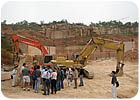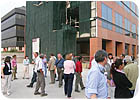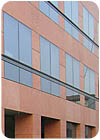
The seventh edition of the Veronafiere-American Institute of Architects (AIA) Continuing Education Seminar on stone, which is sponsored by Stone World Magazine, was held during Marmomacc. On the first day - as part of a series of seminars on the stonework for a new Banco Popolare project in Verona, Italy - participants traveled to see a Rosso Verona marble quarry. There, they learned how the stone is extracted and the importance of specifying a color range when using natural stone.
At the seventh edition of the Veronafiere-American Institute of Architects (AIA) Continuing Education Seminar on stone, which is sponsored by Stone World Magazine, architects from the U.S. and abroad underwent an intensive four-day learning experience in Verona, Italy. The education session combined classroom seminars and site visits on the processing of stone and specific architectural applications. On the opening day of the program, the architects got a first-hand look at all of the steps taken to create the stonework for the new Banco Popolare project in Verona.

Participants also visited a range of processing facilities throughout the Verona region, and industry veteran Vince Marazita was instrumental in leading the tour of these operations.
From there, the tour moved to the next session, “Stone Processing: Sawing, Resin Process, Finishing.†First, the architects visited a marble gangsawing operation to learn how blocks are processed into raw slabs, and then they visited a plant for polishing and applying resin to stone slabs.

Photo by Vince Marazita. The tour concluded at the actual jobsite for the session, “Exterior Cladding Case Study: the new branch of the Banco Popolare.â€
Veronafiere, an AIA CES provider and member of the Marble Institute of America, accepts a total of 15 U.S. architects each year for this program. Architects compete for scholarships that cover tuition, meals, hotel accommodations and local transportation. Each participant is responsible for their own transportation between the U.S. and Verona as well as an administrative fee of $350.

Photo by Vince Marazita. The Banco Popolare project utilizes the stone in a modern application, with simple geometric forms.